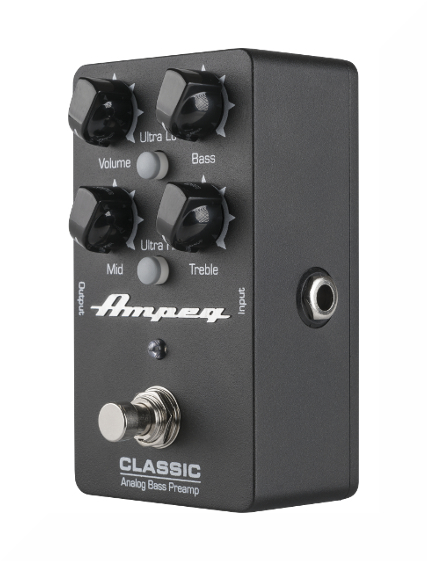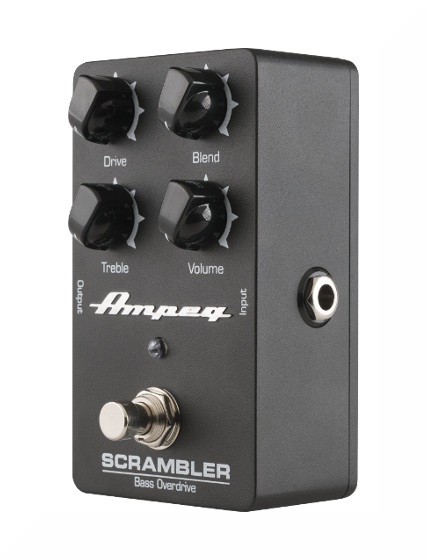New Gear Review: Ampeg’s Classic Analog Bass Preamp & Scrambler Bass Overdrive

With the Classic Analog Bass Preamp and Scrambler Bass Overdrive pedals, Ampeg has parted their popular SCR-DI out into two separate units, offering bassists even further flexibility when dialing in their unique yet classic Ampeg tone.
Bass behemoth Ampeg has always been known for their amplifiers. You’ll find nary a reputable city venue that doesn’t keep some iteration of an SVT in their backline. They’ve been an industry standard since 1969, when the company’s founders set out to build “the biggest, nastiest bass amplifier the world had ever seen.”
The world has changed somewhat since the days of omnipresent “fridges” and unscalable walls of cabinets, and with an increased focus on mobility across all technologies, Ampeg has recently expanded their effects pedal offerings. They’ve effectively divided their SCR-DI, a DI with Ampeg’s classic Scrambler overdrive, into two pedals: the Classic Analog Bass Preamp and the Scrambler Bass Overdrive.
Features and Use
Both pedals are housed in a roadworthy black metal enclosure, with a vivid purple LED and four well-marked knobs for smooth manipulability. Recessed rubber feet on the undersides make these ideal for home use, but they can easily transition to a board.
While Ampeg purports the Classic Analog Bass Preamp is “like having a choice of amps right on your pedal board,” the unit is as far from a modeler as you can get. Dialing in a smooth, round tone may be reminiscent of SVT warmth, but the transparency here will let you find your own voice.
This box is equally versatile as an EQ, boost or cut, and its properties span a wide spectrum. It’ll bring a nice, even thump to a Motown-style finger line or a midrange bite to a picked part in need of some definition.
I used the Classic Bass Preamp while tracking a cover of Chicago’s “If You Leave Me Now” for the FutureCastle EP, a collaboration between NYC groove-rock band Rare Futures and singer/producer Gavin Castleton. The pedal evened out my tone for parts spanning the length of the neck.

Ampeg’s Scrambler Bass Overdrive is the perfect complement to the Classic Analog Bass Preamp, capable of delivering subtle breakup to all-out destruction.
While “grit, grind and sag” may sound like a trifecta of Shredder’s evil henchmen, they are in fact the three qualities that Ampeg’s Scrambler Overdrive delivers, true to the product description on their website. Dial in any, all or name your own tone with the quartet of knobs; from a sprinkle of throaty growl to a Muffy boom, the Scrambler’s Blend knob is your best friend here, while the Drive and Treble knobs will bring the overdrive from subtle to crushing. This Scrambler has more character than the built-in effect on Ampeg’s otherwise winning BA-210 combo, yet is more restrained than the one trick pony guitar fuzz of the same name.
Used in tandem, these pedals really shine. The Classic Preamp bumps the Scrambler into even more punishing territory, and I found myself going back to the former’s settings near 12 o’clock, diming the Scrambler and dialing back the Treble for sludgy metal numbness. These two will get you into the realm of Chris Squire midrange bite as well, and the differences between finger-style and picking really stand out.
To Be Critical
There is very little to critique with these two pedals. Both perform well as Ampeg entry points or as basic tone shaping options, but if you’re after a broader array of features or unique timbres, you’ll want to keep hunting.
Ultimately, I didn’t find the Ultra Lo and Ultra Hi buttons on the Classic Analog Bass Preamp to be entirely necessary, with enough variation coming from the Volume, three-band tone stack and tone knob of my Lakland jazz bass.
The Scrambler, which is an onboard effect on Ampeg’s BA Series combo amps, doesn’t have the low-mid girth that I look for in a go-to overdrive, but its build quality and easy navigation make this a great starter dirt pedal. Using both boxes together solves this thinness issue, which makes sense given their original identity as the single SCR-DI, Ampeg’s answer to the SansAmp.
Summing it Up
Ampeg has always been known for quality and craftsmanship, and these two pedals are no different. Both true bypass and analog, at $99 per unit they’re a cost effective and versatile option for any bassist’s board. While they won’t turn heads with their innovation, it’s nice to see Ampeg back in the pedal game with affordable and reliable options.
Please note: When you buy products through links on this page, we may earn an affiliate commission.






